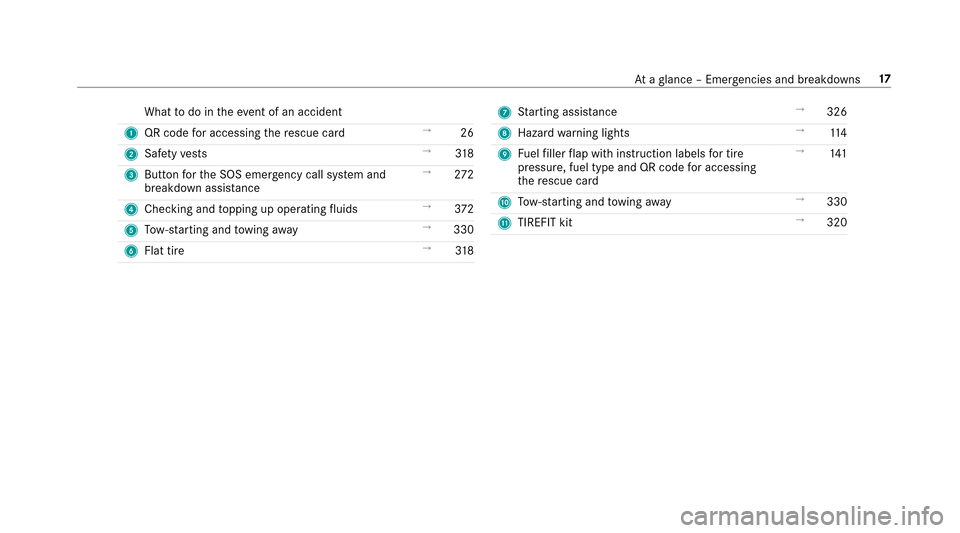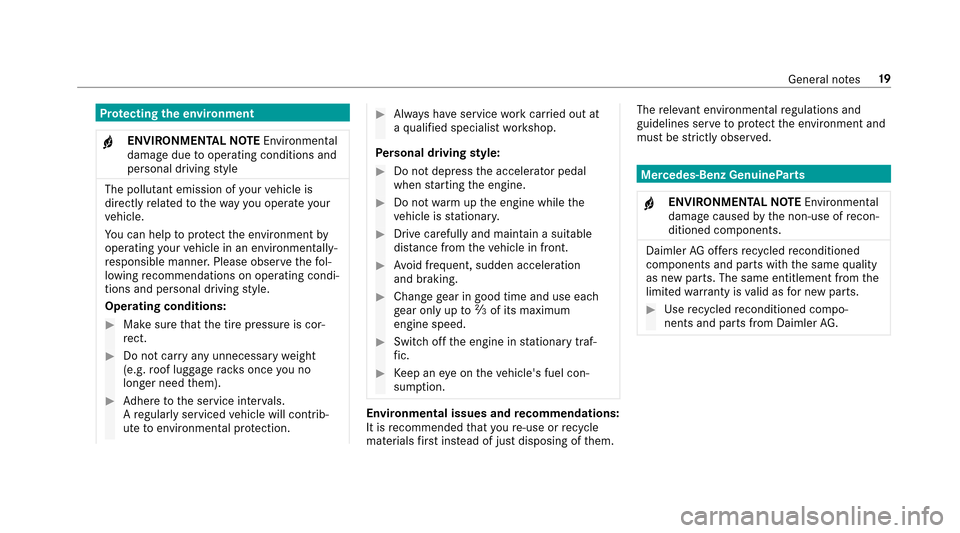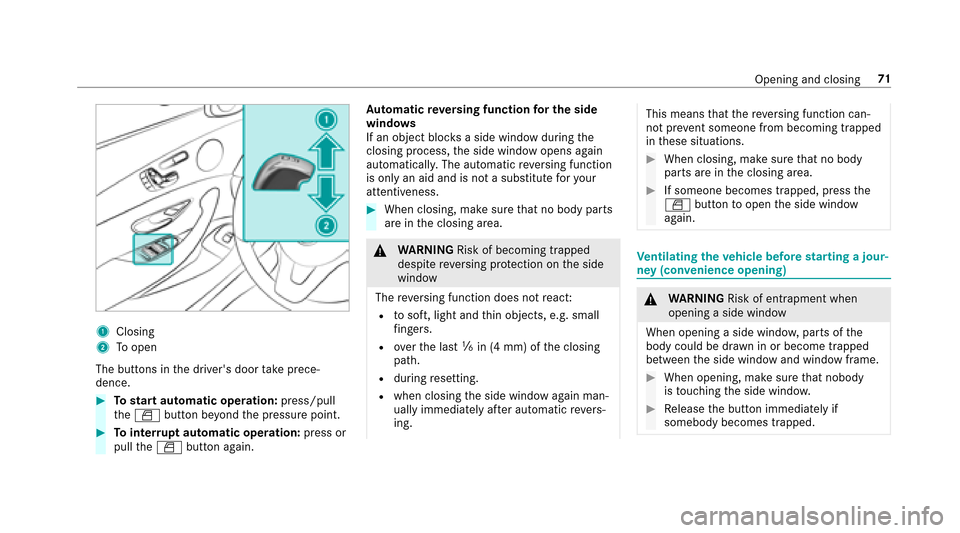2017 MERCEDES-BENZ E43AMG Pressure
[x] Cancel search: PressurePage 5 of 482

Drivingand pa rking ................................. 129
Driving ........................................................ 129
DY NA MIC SELECT switch ............................1 36
Au tomatic transmission .............................. 137
Re fueling ..................................................... 141
Pa rking ...................................................... .143
Driving and driving saf etysy stems ............ .150
Instrument Display and on-board
comp uter .................................................. 199
Instrument Display overview ...................... .199
Overview of the buttons on thesteering
wheel ......................................................... .200
Operating the on-board computer .............. 201
Displa ysinthe multifunction display ......... .202
Ad justing the instrument lighting ............... 203
Menus and submenus ................................ 203
Head-up Display .......................................... 210
Vo ice Control Sy stem ............................... 212
Operating saf ety.......................................... 212
Operation ....................................................2 12
Using Voice Cont rol Sy stem ef fectively ....... 214
Essential commands ................................... 214
Multimedia sy stem .................................. 223
Overview and operation .............................. 223
Sy stem settings .......................................... 231
Na vigation .................................................. 239
Te lephone .................................................. .260
Online and Internet functions ..................... 274
Media ..........................................................2 81
Ra dio .......................................................... 293
Sound ........................................................ .300
Maintenance and care .............................303
ASS YST PLUS service inter val display ........ 303
Engine compartment .................................. 304
Cleaning and care ...................................... .310
Breakdown assistance .............................318
Emergency .................................................. 318
Flat tire ....................................................... 318
Battery (vehicle) .........................................3 24
To w starting or towing away ....................... 329
Electrical fuses ........................................... 334
Wheels and tires ...................................... 338
Noise or unusual handling characteris‐
tics ............................................................ .338
Re gular checking of wheels and tires ......... 338
No tes on snow chains ................................ 339
Ti re pressure .............................................. 339
Loading theve hicle .................................... 345
Ti re labeling ................................................ 350
Definitions for tires and loading ................. 355
Changing a wheel ....................................... 358
Te ch nical data .......................................... 368
No tes on tech nical da ta.............................. 368
Ve hicle electronics .....................................3 68
Ve hicle identification plate, VIN and
engine number ...........................................3 70
Operating fluids .......................................... 372
Ve hicle data ................................................ 378
Displa ymessages and warning/indi‐
cator lamps .............................................. 380
Display messages ...................................... .380
Wa rning and indicator lamps ...................... 423
Contents 3
Page 11 of 482

1Speedom eter →
199
2 ÷ ESP
®
3
#! Turn signal light →
113
4 Ð Steering assis tance malfunction
5 Multifunction displ ay →
202
6 ! ABS malfunction
7 ; CheckEngine
8 Tach ome ter →
199
9 % This indicator lamp has no function
A Elect ric park ing brake applied (red)
F USA only
! Canada only
B Brakes (red)
$ USA only
J Canada only
C # Electrical malfunction
D
· Distance warning
E ? Coolant too hot/cold
F Coolant temp erature gauge →
199
G J Brakes (yell ow)
H ! Electric pa rking brake (yellow)
I 6 Restra int sy stem →
31
J ü Seat belt is not fastened
K T Parking lights →
112
L Fuel le vel indicator
8 Fuelreser vewith fuel filler cap location
indicator
M K High beam →
113
N L Low beam →
112
O R Rear fog light →
113
P h Tire pressure monitoring sy stem
Q å ESP
®OFF
Ataglance – Warning and indicator lamps 9
Page 13 of 482

1Speedom eter →
199
2 ü Seat belt is not fastened
3 #! Turn signal light →
113
4 Multifunction display →
202
5 Tach ome ter →
199
6 å ESP
®OFF
÷ ESP
®
7
K High beam →
113
L Low beam →
112
T Parking lights →
112
8 ? Coolant too hot/cold
9 Coolant temp erature gauge →
199
A · Distance warning
B Ð Steering assis tance malfunction
C # Electrical malfunction
D Brakes (red)
$ USA only
J Canada only
E Fuel le vel indicator
F 8 Fuelreser vewith fuel filler cap location
indicator
G R Rear fog light →
113
H 6 Restra int sy stem →
31
I % This indicator lamp has no function
J ; Check Engine
K J Brakes (yellow)
L Elect ric park ing brake applied (red)
F USA only
! Canada only
M h Tire pressure monitoring sy stem
N ! ABS malfunction
O ! Electric park ing brake (yellow)
Ataglance – Warning and indicator lamps 11
Page 19 of 482

Whattodo in theeve nt of an accident
1 QR code for accessing there scue card →
26
2 Safetyve sts →
318
3 Button forth e SOS emer gency call sy stem and
breakdown assis tance →
272
4 Checking and topping up operating fluids →
372
5 Tow- starting and towing away →
330
6 Flat tire →
3187
Starting assis tance →
326
8 Haza rdwa rning lights →
114
9 Fuelfiller flap with instruction labels for tire
pressure , fuel type and QR code for accessing
th ere scue card →
141
A Tow- starting and towing away →
330
B TIREFIT kit →
320
Ataglance – Emer gencies and breakdowns 17
Page 21 of 482

Protecting the environment
+ENVIRONMENTAL NOTEEnvironmental
damage duetooperating conditions and
personal driving style
The pollutant emission of your vehicle is
directly related tothewa yyo u operate your
ve hicle.
Yo u can help toprotect the environment by
operating your vehicle in an environmentally-
re sponsible manner. Please obser vethefo l‐
lowing recommendations on ope rating condi‐
tions and pe rsonal driving style.
Operating conditions:
#Make sure that the tire pressure is cor‐
re ct.
#Do not car ryany unnecessary weight
(e.g. roof luggage rack s once you no
longe r need them).
#Ad here tothe service inter vals.
A regularly serviced vehicle will contri b‐
ute toenvironmen tal pr otection.
#Alw ays ha veservice workcar ried out at
a qu alified specialist workshop.
Pe rsonal driving style:
#Do not depress the accelera tor pedal
when starting the engine.
#Do not warm upthe engine while the
ve hicle is stationar y.
#Drive carefully and maintain a suitable
dist ance from theve hicle in front.
#Av oid frequent, sudden acceleration
and braking.
#Change gear in good time and use each
ge ar only uptoÔ of its maximum
engine speed.
#Switch off the engine in stationary traf‐
fi c.
#Ke ep an eye on theve hicle's fuel con‐
sum ption.
Environmental issues and recommendations:
It is recommended that youre -use or recycle
materials firs t ins tead of just disposing of them. The
releva nt environmental regulations and
guidelines ser vetoprotect the environment and
must be strictly obser ved.
Mercedes-Benz GenuineParts
+ENVIRONMEN TALNO TEEnvironmental
damage causedbythe non-use of recon‐
ditioned components.
Daimler AGoffers recycled reconditioned
components and part s withthe same quality
as new parts. The same entitlement from the
limited warranty is valid as for new parts.
#Use recycled reconditioned compo‐
nents and part s from Daimler AG.
Gene ral no tes 19
Page 46 of 482

PRE-SAFE®system
Information on PRE- SAFE®(anticipa tory
occupant pr otection)
PRE- SAFE®is able todetect cer tain critical driv‐
ing situations and implement pre-em ptive meas‐
ures toprotect theve hicle occupants.
PRE-SAFE
®can implement thefo llowing meas‐
ures independently of each other:
RTightening the seat belts on the driver's seat
and front passenger seat.
RClosing the side windo ws.
RVehicles with sliding sunroof: Closingthe
sliding sunroof.
RVe hicles with memory function: Adjusting
th e front passenger seat toa more favo rable
seat position.
RVe hicles with multicontour seat: Increas‐
ing the air pressure in the seat side bols ters
of the seat backrest.
RPRE-SAFE®Sound: pr ovided that the multi‐
media sy stem is switched on, generates a brief noise signal
tostimulate the innate pro‐
te ctive mechanism of a person's heari ng.
* NO
TEDama gecaused byobjects in the
fo ot we ll or behind the seat
The automatic adjustment of the seat posi‐
tion may result in damage tothe seat and/or
th e object.
#St ow objects in a suitable place.
Reversing PRE- SAFE®measures
If an accident did not occur, the pre-em ptive
measures that we retaken ar ere ve rsed. You
will need toper form certain settings your‐
self.
#If th e seat belt pre-tensioning is not reduced,
mo vethe seat backrest back slightl y.
The locking mechanism releases.
Information on PRE- SAFE®PLUS (anticipa‐
to ry occupant pr otection plus)
PRE- SAFE®PLUS can de tect cer tain impacts,
particular lyan imminent rear impact, and take
pre-em ptive measures toprotect theve hicle
occupants. These measures cannot necessarily
pr eve nt an imminent impact.
PRE-SAFE
®PLUS can implement thefo llowing
measures independently of each other:
RTightening the seat belts on the driver's seat
and front passenger seat.
If an accident does not occur, the pre-emp‐
tive measures that we retake n are reve rsed .
RIncre asing brake pressure when theve hicle
is stationar y.This brake application is can‐
celed automatically when theve hicle pulls
aw ay.
PRE-SAFE
®PLUS sy stem limitationsRNo measures are implemente d:
-Ifth eve hicle is backing up.
RThe brakes are not applied:
-Whilst driving.
44
Occupant saf ety
Page 69 of 482

With HANDS-FREE ACCESS you can open, close
or inter rupt trunk lid mo vement byper form ing a
kicking mo vement under there ar bumper.
The kicking mo vement triggers the opening or
closing process alternately.
Obser vethe no tes when opening (
→page 63)
and closing (→page 64)th e trunk lid.
% Awa rning tone sounds while the trunk lid is
opening or closing.
& WARNING Risk of burn s causedbya hot
ex haust sy stem
The vehicle exhaust sy stem can become very
hot. If you use HANDS- FREEACCES S,you
could burn yourself by touching theex haust
sy stem.
#Alw ays ensure that you only ma kea
kicking mo vement within the de tection
ra nge of the sensors.
* NO
TEDama getotheve hicle caused by
unin tentional lyopening the trunk lid
RWhen using an automatic car wash
RWhen using a high pressure cleaner
#Deactivate KEYLESS-GO or make sure
that the SmartK eylocated is at least
10 ft(3 m) away from theve hicle in
such situations.
When making the kicking mo vement, make sure
th at you are standing firm ly on the ground, oth‐
erwise you could lose your balance, e.g. on ice.
Re quirements:
RThe SmartK eyis behind theve hicle.
RStand at least 12in (30 cm) away from the
ve hicle while per form ing the kicking mo ve‐
ment.
RDo not come into contact with the bumper
while making the kicking mo vement.
RDo not car ryout the kicking mo vement too
slowl y.
RThe kicking mo vement must be towa rdsth e
ve hicle and bac k.
1Sensor detection range
If se veral consecutive kicking mo vements are
not successful, waitte n seconds.
Sy stem limitations
The sy stem may be impaired or may not function
if:
RThe area around the sensor is dirty, e.g. due
to road salt or snow .
RThe kicking movement is made using a pros‐
th etic leg.
Opening and closing 67
Page 73 of 482

1Closing
2Toopen
The buttons in the driver's door take prece‐
dence.
#To start automatic operation: press/pull
th eW button be yond the pressure point.
#To inter rupt automatic operation: press or
pull theW button again. Au
tomatic reve rsing function for the side
windo ws
If an object bloc ksa side wind owduring the
closing process, the side window opens again
automaticall y.The automatic reve rsing function
is only an aid and is not a substitute foryo ur
attentiveness.
#When closing, make sure that no body parts
are in the closing area.
&
WARNING Risk of becoming trapped
despite reve rsing pr otection on the side
window
The reve rsing function does not react:
Rto soft, light and thin objects, e.g. small
fi ngers.
Rove rth e last ãin (4 mm) of the closing
path.
Rduring resetting.
Rwhen closing the side window again man‐
ually immediately af ter au tomatic reve rs‐
ing.
This means that there ve rsing function can‐
not pr event someone from becoming trapped
in these situations.
#When closing, make sure that no body
parts are in the closing area.
#If someone becomes trapped, press the
W button toopen the side window
again.
Ve ntilating theve hicle before starting a jour‐
ney (con venience opening)
&
WARNING Risk of entrapment when
opening a side window
When opening a side windo w,parts of the
body could be dr awn in or become trapped
between the side window and window frame.
#When opening, make sure that nobody
is touching the side windo w.
#Release the button immediately if
somebody becomes trapped.
Opening and closing 71